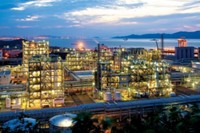Advertisement
Grab your lab coat. Let's get started
Welcome!
Welcome!
Create an account below to get 6 C&EN articles per month, receive newsletters and more - all free.
It seems this is your first time logging in online. Please enter the following information to continue.
As an ACS member you automatically get access to this site. All we need is few more details to create your reading experience.
Not you? Sign in with a different account.
Not you? Sign in with a different account.
ERROR 1
ERROR 1
ERROR 2
ERROR 2
ERROR 2
ERROR 2
ERROR 2
Password and Confirm password must match.
If you have an ACS member number, please enter it here so we can link this account to your membership. (optional)
ERROR 2
ACS values your privacy. By submitting your information, you are gaining access to C&EN and subscribing to our weekly newsletter. We use the information you provide to make your reading experience better, and we will never sell your data to third party members.
Petrochemicals
Celanese venture is making methanol from carbon dioxide
Company says carbon capture aided in a low-cost expansion
by Alexander H. Tullo
January 17, 2024
| A version of this story appeared in
Volume 102, Issue 2

Fairway Methanol, a joint venture between Celanese and Mitsui & Co., has started up a carbon capture and utilization system at Celanese’s plant in Clear Lake, Texas, that turns 180,000 metric tons (t) per year of the greenhouse gas carbon dioxide into 130,000 t of methanol.
While most methanol is produced by reacting hydrogen with carbon monoxide, the new project reacts hydrogen with CO2 instead. The CO2 comes from chemical plants in the vicinity and Celanese itself. The hydrogen is what Celanese calls in an e-mail to C&EN “fossil hydrogen with lower carbon intensity compared to conventionally produced hydrogen.”
Celanese isn’t providing more details about the raw materials, but in 2022, the industrial gas maker Linde announced that it would supply Fairway with hydrogen and with CO2 captured from its nearby carbon monoxide plant, avoiding, Linde claims, CO2 emissions. “By using the carbon dioxide captured from Linde’s facility, the hydrogen supplied by Linde will also have a lower carbon intensity,” Linde’s press release said at the time.
According to Mark Murray, senior vice president of acetyls at Celanese, the hydrogen and CO2 are being added to Fairway’s existing reactor. The carbon capture project expanded the plant’s capacity by nearly 10% at a cost of $50 million—a cheaper investment on a per-metric-ton basis than a new carbon monoxide–based methanol plant would have been. “We didn’t do this purely for CO2 reduction. We did it for a low-cost bottlenecking,” Murray says.
Celanese will use the methanol to make acetic acid, a raw material for chemicals such as vinyl acetate, a precursor for coating and adhesive resins. It will market the products under its Eco-CC brand to promote its captured-carbon content.
The company isn’t yet disclosing how much carbon emissions the system avoids, though it says it is sharing life-cycle analysis data with potential customers.
Mike Nash, vice president of syngas chemicals for the consulting firm Chemical Market Analytics by OPIS, says low-carbon methanol is mostly being used as a fuel for ships. He also sees interest in using it to make adhesives and paints, “but the key questions are what premium does Celanese want, and will this be achievable in the market?” Nash says in an email.
Celanese isn’t the first company to make methanol from CO2, although it says it is among the world’s largest practitioners of the method. In Trinidad, Proman pipes CO2 emissions from its ammonia plants to its nearby methanol unit. Qatar Fuel Additives Company, a methanol producer in Qatar, runs a similar process. And recently, Jiangsu Sailboat Petrochemicals started up a dedicated CO2 -to-methanol plant in China based on technology from Carbon Recycling International.



Join the conversation
Contact the reporter
Submit a Letter to the Editor for publication
Engage with us on Twitter